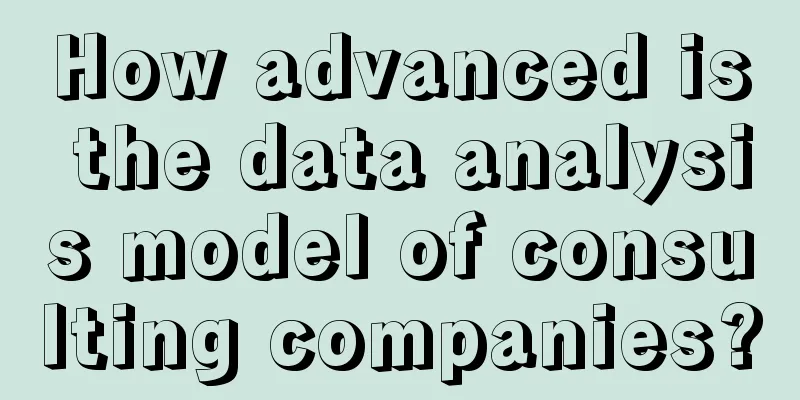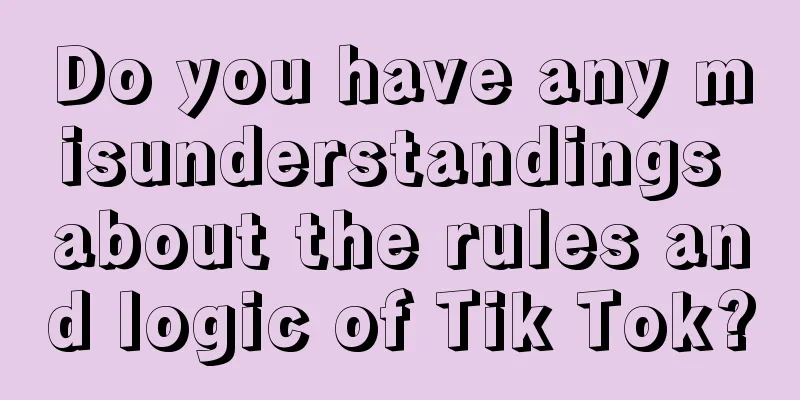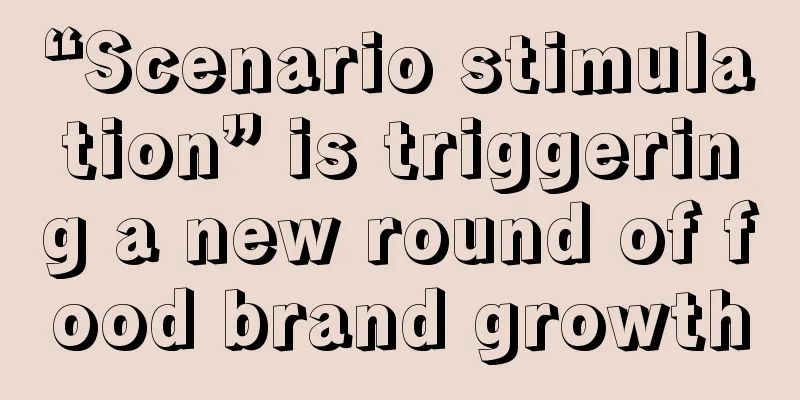How advanced is the data analysis model of consulting companies?

Students who do data analysis have all seen the matrix below. Many people worship it. Some online writers even directly refer to matrix thinking, matrix model, and matrix method, saying that it is the "underlying idea" and "core logic" of data analysis. Well... they definitely have never worked in a consulting company. Let's take a look at the truth behind this. 1. Starting from the average methodThe average is the most used and most ridiculed concept. As the poem proves: Village head old Zhang ten million Nine poor guys next door Calculate it at the Statistics Bureau Each of them is Zhang Baiwan But the question is, why is the average so much criticized, but is it actually the most commonly used? There are three concepts in statistics: mean, median, and mode, and all three concepts are easy to understand, but why is it not the mean? Answer: Because the average is easy to use and saves time. Using the average, we can easily break down the total amount by person, for example: Sales amount = number of purchasing customers * average purchase amount per person Production quantity = number of production lines * average capacity Stock quantity = number of stores * average sales volume This makes management much easier: if you want to increase sales, you either need to increase the number of customers or increase the average purchase. These two numbers can be simply multiplied directly. Using the median or mode obviously cannot achieve this effect. Moreover, the order was also very clear: Everyone must perform above average! If you can't do it, you will hold everyone back. If everyone can do it, why can't you? You see, it is simple and clear, and it conforms to people's intuitive feelings and is very convincing. So the average is a self-contained standard. Above the average is good, below the average is bad. This is very important for consultants. Because most consultants have far less experience in a specific industry than their clients do, when diagnosing problems, consultants need a neutral, persuasive standard that is not dependent on the industry to judge whether something is good or bad. Only after judging whether something is good or bad can they further analyze why it is good or bad. Therefore, the average method is the most commonly used judgment method. Of course, the average method also has its inherent shortcomings, which leads to other methods. 2. Iterative upgrade of the average methodThe problem with using averages actually comes from the huge individual differences, as the saying goes: "I have the average height as Yao Ming and I have the average wealth as Jack Ma." Therefore, on the basis of the average method, the 80/20 rule was introduced: according to the 20/80 theory, the best top 20% are directly separated and observed separately to avoid interfering with other groups, so that judgments can be made. The 80/20 rule is usually used more in the front office/marketing end. Because the production and logistics of the back office/supply end are mechanized processes, it is easy to control the quality, but in the front office/marketing end, there are often a few capable sales people who make a lot of achievements, and a few financial sponsors contribute most of the profits. In management, the gold panning method is derived. That is, recruit 100 sales people and cultivate 20 Ace-level sales people from them. It is similar to the process of digging a pile of sand and panning for gold. What if there are two evaluation dimensions? This leads to the matrix method. 3. From the Average Method to the Matrix MethodThe matrix method is essentially a method of finding a judgment standard using two dimensions. Its operation is very simple: The first step is to find two evaluation dimensions and take the average value of each dimension as the judgment standard. In the second step, the two indicators are crossed to obtain the object to be evaluated. The third step is to give a classified interpretation based on the meaning of the two dimensions. As long as the correlation between two indicators is not very high, when the two indicators intersect, the data will be scattered in four matrices, so that the business meaning can be clearly found (as shown below). What’s more interesting is that if the two evaluation dimensions are combined properly, many interesting business implications can be revealed. For example, the two indicators of user activity/user payment in the gaming industry can be: ☆ High activity + high payment = Golden Cow users (those who contribute both money and effort) ☆ Low activity + high payment = rich users (too lazy to play by myself, I will pay for it!) ☆ High activity + low payment = free users (la la la, just play without paying) ☆ Low activity + low payment = marginal users (not playing much, leaving) Such interpretation can liven up the atmosphere of the report, and combined with the so-called "matrix model", it looks both high-end and lively, which is what the client fathers like to see the most. Therefore, the matrix model has become popular. Every consulting company will teach how to build a matrix model during the training of new employees to satisfy the fathers. This is an ancestral craft. So the so-called analysis models you see in consulting companies are mostly matrices, all kinds of matrices. If the matrix is not working, it will basically be a very complex model with many classification dimensions, such as 7S and 9P. Students who are quick to react will immediately have questions when they see this. "Huh? Why is it like this? In theory, the evaluation of the three dimensions can also be superimposed like this, isn't it just a cross table?" Taking the three-dimensional evaluation as an example, even if each dimension is classified into two categories, there are still 2*2*2=8 categories that can be divided. In this case, several problems will arise: 1. The interpretation of each type of meaning becomes complicated and may not be able to be explained clearly. 2. The number of each group decreases, and it is common for one group to account for 50% and the other 5%. 3. Due to the uneven size of the groups, customers often ask us to further segment them. However, the more fragmented the segmentation is, the more difficult it is to interpret. Moreover, for some customers, even if 50% of the users have zero consumption and zero activity, we cannot go any further. In short, the original use of the average method and the matrix method was for simplicity and convenience. Now, they have artificially created complexity. Therefore, when the evaluation dimensions exceed 3, consultants tend to abandon manual classification and directly use a comprehensive evaluation model that includes a large number of classification dimensions. Or simply use K-means clustering and interpret the clustered results in their heads. IV. SummaryThe so-called analysis models and methods all have specific use backgrounds, purposes, and effects. Moreover, not all analysis methods are aimed at "precision". The ultimate goal is to solve the problem quickly and easily. This is another case of "gentlemen think of literature, while villains think of God". If you seriously understand the logic behind it, you will make progress. If you memorize it by rote under the guise of "authority, awesomeness, and science", you will get yourself into trouble. |
<<: How to expand your business and acquire more customers through TikTok?
Recommend
After watching the World Cup, there are still many good copywritings to read
The charm of football is not only in winning the g...
How is Amazon's disposal fee calculated? How do you remove inventory?
As the Amazon platform continues to grow, more and...
Female consumers, the eternal growth of brands
Female consumers account for the vast majority of ...
Brand marketing leveraging momentum, underlying logic and case analysis
Editor's note: Many brands have their own cons...
Can Facebook sell products? Can it sell virtual products?
Facebook, also known as "Facebook", has ...
How long can Wahaha continue to reap the benefits of traffic?
Wahaha, which became popular in March, has reaped ...
Will the points deducted by Shopee be reset to zero every month? How many points will Shopee deduct before freezing the account?
Today, I will introduce you to the content of open...
Why are there huge market opportunities for 24-hour soy milk restaurants?
After getting off work late at night, you can alwa...
What are the advantages of Amazon local company accounts? How to choose?
You will apply to open a store on Amazon. Whether ...
What is Shopify? What are the advantages of Shopify?
There are actually quite a lot of merchants doing ...
Amazon will update the logistics process of creating shipments
Amazon Global Selling announced that the "Sen...
Starbucks awaits long recovery
Faced with increasingly fierce competition and pri...
How brands can play with small categories
In recent years, with the continuous upgrading of ...
Analyzing the five classic advertisements of the creative marketing giant "Mixue Ice City"
Mixue Ice City, a ready-made beverage company that...
What to do if Amazon products are unsalable? How to know if they are unsalable?
The sales volume of Amazon products is the top pri...









